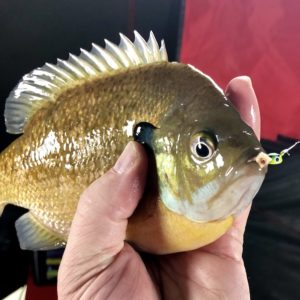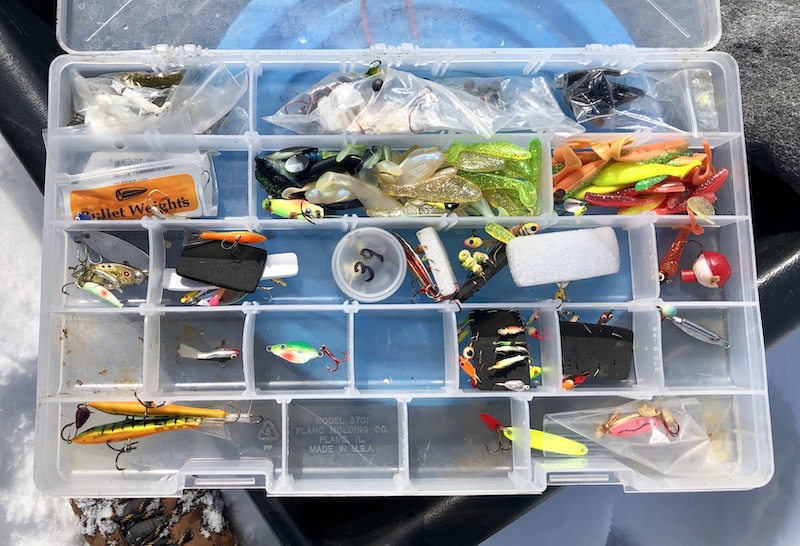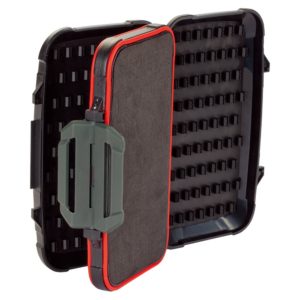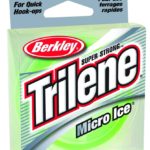In recent years, tungsten ice fishing jigs have become quite popular. But what advantages do they have over traditional lead jigs? When should you choose lead jigs over tungsten? In this article I’ll explain…
Lead is Dead: Long Live Tungsten
Ok, that’s an exaggeration.
Lead jigs have been used in ice fishing for ages, and for good reason.
Just like choosing the right ice fishing rod, jig selection is hugely important to your success when the going gets tough.
Lead works well because it is dense, which means it is heavy. That’s why it’s such a popular material for fishing tackle. And yes, lead still has a place in my ice fishing arsenal. I’ll discuss that in a bit, so keep reading.
First I want to talk about tungsten.
Tungsten is MORE dense than lead. It’s MORE heavy.
That means that a tungsten jig is going to weigh more than a lead jig of the same size. That is the primary benefit of tungsten jigs, and why they are so great for specific fishing styles and presentations.
Tungsten ice jigs are a little more expensive than lead, but prices have come down. You can check out your local tackle shop, and there are lots of affordable options available on Amazon.
Tungsten vs Lead Density
Tungsten has a density of 0.70 lbs per cubic inch.
So if you had a perfect cube of pure tungsten measuring one inch on all sides, it would weigh 0.70 pounds.
Big deal, right?
Actually, that’s 1.74 times heavier than the same amount of lead!
Why Jig Weight Matters
When ice fishing (especially for panfish), we are often using extremely light line and extremely small jigs.
Like really, really small. Especially when fishing for bluegill, which have very small mouths in relation to the size of their bodies.
Small jigs with small hooks work best for tight-lipped panfish when the going gets tough.
Since a tungsten ice fishing jig is so much heavier than a lead one of the same size, it has a number of advantages.
Less Line Coil
Fishing line has a tendency to coil up. It is stored on the spool of your reel, and over time, the line tends to keep that coiled shape.
This is known as “memory”. Some types of fishing line (such as braid) has less memory, while mono can have quite a bit. This effect is even more pronounced in cold temperatures.
Using high quality ice fishing line can help with this. In fact, my current favorite line for ice fishing is designed to minimize line coil at cold temperatures.
I’ve been using Trilene Micro Ice, which has low memory, low stretch, and is available at a good price. Check it out on Amazon.
But high quality line is just part of the solution. Memory can still be an issue, and we’re looking for every advantage we can get.
If your line is coiled, you have less direct contact with the fish. And the deeper the water, the bigger this issue becomes.
Tungsten jigs weigh a lot more than lead, so they can help keep your line tight. A tight line can be the difference between landing a fish, or not even noticing a bite.
Small Jigs, Deep Water
This is related to the line coil issue mentioned above.
When fishing in deeper waters, your line will have even more room to expose coiling issues. And sometimes, those fish are stuck tight to the bottom, and they don’t want to move.
When the bite is tough, and the fish don’t want to move or take a larger bait, the ability to get the smallest jig possible down to the bottom (fast) is critical.
That brings me to my next point.
Better Contact With Your Jig (and the Fish)
Tungsten jigs fall faster and hang tighter than their lead counterparts.
Even when jigging slightly, the tungsten jig will tighten back up more quickly, keeping you in contact with the jig. When that fish decides to take a nip at it, you’ve got a better chance of detecting that bite.
Ground and Pound

Often, when panfish are stuck to the bottom, I find it effective to let my jig sink like a rock and hit that bottom.
I’ll let it sit there, then periodically bang it against the bottom.
If the bottom is soft or muddy, this can mimic the activity of a small larvae wiggling around in the muck.
If the substrate is hard, like gravel, sand, or rock, it can create noise.
Tipping your jig with wax worms adds scent and taste to your presentation, and this jigging, banging action can help distribute the scent of your bait.
Since panfish use sight, smell, and sound to find prey, this can be an effective technique in a variety of fishing situations.
When the bluegills are responding to ground and pound, tungsten is always going to be my preferred choice.
Tungsten jigs are great for this, because they fall fast, make more noise when hitting a hard bottom, and (as mentioned previously) help you maintain contact with the jig.
When Lead is Better Than Tungsten
Ok, I spent half this article extolling the virtues of tungsten ice fishing jigs. But despite my “Lead is dead” comment, lead can be just as important a player in certain situations.
Lead Falls Slower
You may have noticed that some species (like crappie) tend to feed upward. Sometimes a slow, gradual trip to the bottom is the only thing those fish want to see. OR at least the only thing they want to strike.
Since lead is lighter than tungsten, it falls more slowly.
When you’re on a bite where the fish seem to want to take a bait on the fall, lead can be a better choice. Especially when you choose the right jig shape.
Jigs with flat sides or bottoms will tend to drift, flutter, and change direction as they fall. This can be attractive to some species. I’ve especially noticed crappie and walleye/sauger to respond well to a slow, measured descent.
The key is to always maintain contact with your jig, and pay attention to those electronics if you have them.
You still want to use low-memory line to assist with lure contact, and to keep coiling and stretch to a minimum. That way you can more easily detect bites that come on the fall.
Lead And Tungsten, a Killer Combination
Once you’ve identified what the fish are responding to, you can dial in your approach using careful jig selection.
If fish are rising to the bait, and seem apt to strike as the jig falls through the water column, switch to a lead jig with flat surfaces.
This can further slow down the jig as it sinks, and give it more time to draw the attention of the fish below.
When the fish are tight to the bottom and don’t want to come up more than an inch or two to even look at your bait, I go with a rounder shaped jig made of tungsten.
It will get down to the fish in a hurry, and let you pound the bottom to attract attention.
Organization = Production
Organizing your jigs (and all of your gear) is crucial when ice fishing. Sometimes the prime window of feeding activity can be pretty short. You don’t want to be digging through a bunch of stuff at the bottom of a bucket to find what you want.
As you can see, I’ve been there. What a mess!


It’s important to find out what the fish are responding to as quickly as possible. If using multiple rods is legal in your state, try a slow falling, fluttering lead jig shape on one rod, and a ground-pounding tungsten on the another.
When the bites start coming, you need to be able to quickly adapt to the circumstances.
It can be tricky to keep a wide variety of ice fishing jigs organized, but it’s important to do so.
I’ve been guilty in the past of letting my jig collection turn into mass confusion by the end of an outing, and it only gets worse as the season does on.
These days, I try to be better about keeping my jigs organized, and PUTTING JIGS BACK WHERE THEY GO when I tie a new one on. It takes discipline, but it pays off.
I like to keep my jigs organized by material (lead vs tungsten), by size, and by shape.
A couple of well-designed jig boxes (like this one on Amazon) will make it much easier to quickly grab the exact lure you are looking for.
Color matters too, but I like to dial in my presentation style before I start messing with color changes. But make no mistake, sometimes a color change can make a big difference.
Conclusion
Both tungsten and lead have important roles to play in ice fishing.
It’s all about finding the fish, then quickly determining a presentation that works. This is especially important on a pond or lake you’ve never fished before. On familiar lakes, you can usually work out something that generally works, and fine tune from there.
As with all fishing, conditions change, and what works one day can be a dead flop the next. That’s why it’s important to have a wide selection of ice fishing jigs in various shapes, sizes, colors, and materials.
You don’t want to be missing out on a great bite because you can’t provide what the fish want to see.
I hope you found this article informative, and I REALLY hope it helps you put more tasty panfish on the ice.
Now gear up, and GO FISHING!



One comment
Comments are closed.